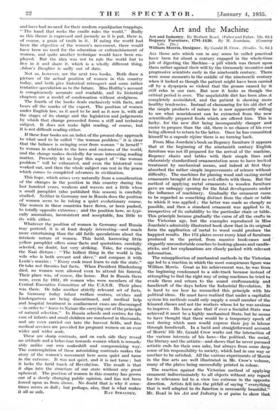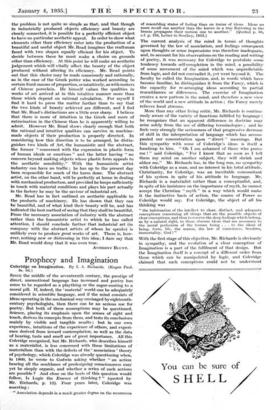Art and the Machine
William Morris, Designer. By Gerald H. Crow. (Studio. 7s. 6d.)
ALL those arts which can in any sense be called practical have been for about a century engaged in the whole-time job of digesting the Machine—a pill which was thrust upon them rather against their will by the tiresomely inventive and progressive scientists early in the nineteenth century. There were some moments in the middle of the nineteenth century when it looked as though the patient might have been carried off by a dyspepsia so violent that the groans caused by it still echo in our ears. But now it looks as though the critical period is over. The unpalatable diet has been almc3t completely assimilated, and the patient is showing more healthy tendencies. Instead of clamouring for his old diet of the simple products of nature he is now apparently willing to see what nourishment can be extracted from the new scientifically prepared foods which are offered him. This is lucky, for the new diet being incomparably cheaper and easier to prepare than the old, there is no chance of his ever being allowed to return to the latter. Once he has committed himself to a capsule regime there is no turning back.
From Miss Jourdain's book on Regency furniture it appears that at the beginning of the nineteenth century English furniture was not ill prepared for the arrival of the machine. Regency chairs and tables with their simple lines and elaborately standardized ornamentation seem to have invited treatment by mechanical means, and indeed at first they absorbed the rather simple improvements of science without difficulty. The machines for planing wood and casting metal ornaments brought at first no evil effects with them. But the method of applying metal ornaments to wooden furniture gave an unhappy opening for the fatal developments under the influence of machinery. Gradually the ornament came to be regarded as something distinct from the chair or table to which it was applied ; the latter was made as cheaply as possible, and then a standard ornament was applied to it, irrespective of its suitability to the particular chair or table. This principle became gradually the curse of all the crafts in the Victorian age, but the examples reproduced in Miss Jourdain's admirably illustrated book show that in its original form the application of 'metal to wood could produce the happiest results. Her 173 plates cover every kind of furniture produced in the period, from massive book-cases and elegantly uncomfortable couches to looking-glasses and candle- sticks, and her explanations are closely packed with relevant information.
The misapplication of mechanical methods in the Victorian age led to a reaction in which the most conspicuous figure was William Morris. Great as his achievement was, he was from the beginning condemned to a side-track because instead of attempting to find the right way of using machines he tried to evade them and return to the sound craftsmanship and handicraft of the days before the Industrial Revolution. It is hard to see how he reconciled this principle with his political ideas. He must have realized that under a capitalist system his methods could only supply a small number of the leisured classes and not the workers whose lot he was anxious to improve. He knew also that if ever a Socialist State was achieved it must be a highly mechanized State, but he seems to have thought that there would be a temporary epoch of rest during which men would express their joy in labour through handicraft. In a lucid and straightforward account of Morris' life Mr. Gerald Crow works out the interaction of the various interests of his hero—the political, the social, the literary and the artistic—and shows that he never pursued artistic ends for their own sake, but always from some deep sense of his responsibility to society, which had in one way or another to be satisfied. All the various experiments of Morris in the fine arts are well illustrated in Mr. Crow's volume, many of the plates being successfully printed in colour.
The reaction against the Victorian method of applying ornament indiscriminately to all objects without any regard for its relevance led to a view too extreme in the opposite direction. Artists fell into the pitfall of saying " everything that is well adapted to its function is necessarily beautiful." Mr. Read in his Art and Industry is at pains to show that the problem is not quite so simple as that, and that though in industrially produced objects efficiency and beauty are closely connected, it is possible for a perfectly efficient object to have no particular aesthetic appeal. In order to show what elements other than efficiency enter into the production of a beautiful and useful object Mr. Read imagines the craftsman faced with two shapes equally efficient for his object. TO decide between these he must make a choice on grounds other than efficiency. At this point he will make an aesthetic judgement which will vitally affect the beauty of the object produced without altering its efficiency. Mr: Read points out that this choice may be made consciously and rationally, -as in the case of the Greek potter who worked according to certain fixed canons of proportion, or intuitively, as with makers of Chinese porcelain. He himself values the qualities in works of art arrived at in this intuitive manner more than those which depend on rational calculation. For myself I find it hard to press the matter further than to say that the two kinds of beauty achieved are different, and I feel that Mr. Read's distinctions are a little over sharp. I believe that there is more of intuition in the Greek and more of ratiocination in the Chinese than he is apparently willing to admit. However Mr. Read shows clearly enough that both the rational and intuitive qualities can survive in machine- made objects if their production is properly directed. In considering how this direction is to be arranged, he distin- guishes two kinds of Art, the humanistic and the abstract, the former " concerned with the expression in plastic form of human ideals or emotions " and the latter having " no concern beyond making objects whose plastic form appeals to the aesthetic sensibility." With the humanistic artist industry can have no traffic ; he has up to the present day been responsible for much of the harm done. The abstract artist, on the other hand, will be perfectly at home in dealing with mechanical production, and provided he keeps sufficiently in touch with material conditions and plays his part actually in the factory he may be the saviour of industrial art.
Mr. Read has in fact outlined an aesthetic applicable to the products of machinery. He has shown that they can be beautiful, and of what kind their beauty will be, and has indicated the best method of seeing that they shall be beautiful. From the necessary association of industry with the abstract rather than the humanistic artist to which he has called attention, I should conclude further that industrial art (in company with the abstract artists of whom he speaks) is unlikely ever to produce great works of art. There is, how- ever, nothing new or distressing in this idea; I dare say that Mr. Read would deny that it was even true.
AwrIIoNY BLUNT.







































 Previous page
Previous page